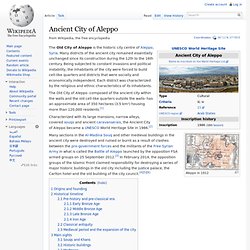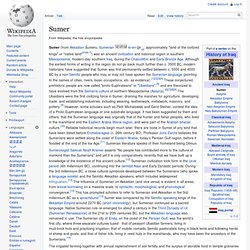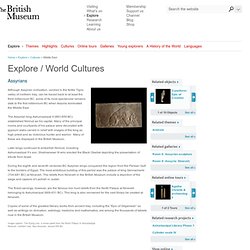

Ancient City of Aleppo. Aleppo in 1912 The Old City of Aleppo is the historic city centre of Aleppo, Syria.

Many districts of the ancient city remained essentially unchanged since its construction during the 12th to the 16th century. Being subjected to constant invasions and political instability, the inhabitants of the city were forced to build cell-like quarters and districts that were socially and economically independent. Each district was characterized by the religious and ethnic characteristics of its inhabitants. The Old City of Aleppo -composed of the ancient city within the walls and the old cell-like quarters outside the walls- has an approximate area of 350 hectares (3.5 km²) housing more than 120,000 residents.[1] Characterized with its large mansions, narrow alleys, covered souqs and ancient caravanserais, the Ancient City of Aleppo became a UNESCO World Heritage Site in 1986.[2] Origins and founding[edit] Pattern of ancient Aleppo Ancient Aleppo Historical timeline[edit] Early Bronze Age[edit]
Sumer. The irrigated farming together with annual replenishment of soil fertility and the surplus of storable food in temple granaries created by this economy allowed the population of this region to rise to levels never before seen, unlike those found in earlier cultures of shifting cultivators.

This much greater population density in turn created and required an extensive labour force and division of labour with many specialised arts and crafts. At the same time, historic overuse of the irrigated soils led to progressive salinisation, and a Malthusian crisis which led to depopulation of the Sumerian region over time, leading to its progressive eclipse by the Akkadians of middle Mesopotamia. Sumer was also the site of early development of writing, progressing from a stage of proto-writing in the mid 4th millennium BC to writing proper in the 3rd millennium BC (see Jemdet Nasr period). Early Civilizations - Mr. E. Mesopotamian City by ~r-w-shilling on deviantART. Dan - the Canaanite (Bronze Age) city. Dan - Canaanite City This web page focuses on the Canaanite (Bronze age) city in Tell Dan - the Biblical city of Laish/Leshem.

Genesis 14:14: "And when Abram heard that his brother was taken captive, he armed his trained servants, born in his own house, three hundred and eighteen, and pursued them unto Dan". Home > Sites > Upper Galilee > East > Dan - Canaanite City Background: Mesopotamia: First Cities. Amorites. The Amorites were the indigenous people of central inland and northern Syria.

They spoke a Semitic language related to modern Hebrew. During the Early Bronze Age (3200-2000 BC), they developed powerful states such as those centred on Ebla, Carchemish and Aleppo. Enclosed behind large fortification walls, these cities had elaborate palace and temple buildings. The Amorites maintained close diplomatic and trading relations with cities in Mesopotamia to the east and south. This contact is reflected in their art and architecture which is often influenced by that of Mesopotamia. Many cities in Syria, including Ebla were destroyed around 2300 BC, possibly as part of the military expansion of the kings of Akkad from southern Mesopotamia. Assyrians. Although Assyrian civilization, centred in the fertile Tigris valley of northern Iraq, can be traced back to at least the third millennium BC, some of its most spectacular remains date to the first millennium BC when Assyria dominated the Middle East.

The Assyrian king Ashurnasirpal II (883-859 BC) established Nimrud as his capital. Canaanites. The Canaanites were the indigenous people of the ancient Levant (modern Israel, Palestine, Transjordan, Lebanon and coastal Syria).

They spoke a Semitic language related to Hebrew. During the Early Bronze Age, as trade with Egypt increased, strongly defended cities developed throughout the region which formed the centres of independent states. Egyptian campaigns were occasionally launched against some Canaanite cities but relations were normally maintained through trade. Starting around 2000 BC, Canaanites began to infiltrate the Egyptian Delta, and their donkey caravans can be seen on a number of Egyptian tomb paintings. PHA6016-cl.jpg (1058×774) Mesopotamian Housing – Empty Headed, Paper & Pencil.
In my class, we’re learning about the ancient Mesopotamian civilization and culture.

Our assignment was selecting a specific topic based on the Mesopotamian civilizations, I and my partner chose ‘Mesopotamian Housing’. We selected our topic and written a single paragraph on our topic and at the end, presenting our topic to the class. I fairly believe that I and my partner did well, we spoke clearly and loudly and made sure the audience understands our topic. We understood our topic well enough for us to present it without reading it off or using much notes. And I too, believe that we had done well on our paragraph; that has clear beginning and clear ending. Mesopotamian Housing. MesopotamianCities.jpg (577×599)